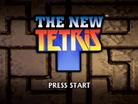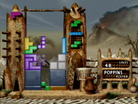The New Tetris
| The New Tetris | |
|---|---|
| Developer(s) | H2O Entertainment |
| Publisher(s) | Nintendo of America |
| Platform(s) | Nintendo 64 |
| Release | 02 Aug 1999 (US) |
| Gameplay info | |
| Next pieces | 3 |
| Playfield size | 10w x 20h |
| Hold piece | yes |
| Hard drop | "Firm" drop (with lock delay) |
The New Tetris for N64 was developed by H2O and published by Nintendo. Like Tetrisphere before it, The New Tetris features a soundtrack by Neil Voss.
It has lock delay, soft and firm drop, 4×4 squares, hold piece (though not IHS), three next pieces, ghost piece (TLS), and milder wall kick than SRS (notably, T-spin triples don't work but lock delay is still abusable on no-garbage play). The speed never gets anywhere near 20G. [oh? roughly where does it top out?] Colors of some tetrominoes differ from those of the Tetris Guideline: L is magenta, T is yellow, and O is light gray.
Top-out condition is the same as in Atari's Tetяis and the "push" mode of Nintendo's Tetris DS: the game ends when one block is placed above the playfield's top row.
The New Tetris defines twists (known in the manual as "spin moves") differently from the "T-spin" rule used in Tetris Worlds, Tetris DS, and other games that use SRS. In this game, a twist occurs when a tetromino locks in a position such that it cannot move left, right, or up without rotating.
Squares
- Main article: Square Platforming
A monosquare is a 4x4 block square made out of four identical tetrominoes. A multisquare is any 4x4 block square made out of four tetrominoes.
Details
If a tetromino forms two overlapping squares at once, the gold wins over silver, the top wins over the bottom, and the left wins over the right. It is not known whether the top-right wins over the bottom-left.
|
Two O, an L, |
Drop in another L |
Prefers the square |
|
|
|
|
Given that The New Tetris is proprietary software, the public does not know exactly how the detection is implemented, but its behavior is identical to that of the algorithm described below:
The playfield is stored as a matrix of 10 columns by 20 rows. Each entry has 4 bits for color, 1 bit for right connection, 1 bit for down connection, 1 bit for left connection, and 1 bit for up connection.
Before and after checking for lines, the engine scans the playfield top to bottom, left to right, first looking only for squares of one color and marking them as gold, then looking for any squares of one color and marking them as silver. To see if there is a square whose lower left corner is (x, y): #Make sure that the left edge isn't connected to anything. That is, make sure that the blocks at (x, y), (x, y + 1), (x, y + 2), and (x, y + 3) don't have their left connection bit set to true, and do the same for the other four edges.
- Make sure that all blocks in the 4x4 square region are filled.
- Make sure that all blocks in the 4x4 square region belong to whole tetrominoes (not tetrominoes with a piece broken off, and not pieces of 4x4 squares). Lockjaw does this by turning the blocks of any tetromino that has a piece broken off into (gray) garbage. TNT does not; it is unknown what data structure it uses.
Scoring
- 1 point per line cleared
- 1 bonus point if four lines cleared simultaneously (tetris)
- 5 bonus points when a 1×4 strip of silver square is cleared
- 10 bonus points when a 1×4 strip of gold square is cleared
- no instant reward for
- completing a 4x4 square
- spin moves (twists)
The greatest possible reward for a single move is therefore 85, as in the following case:
The total of 85 is made up of:
- 4 from the four lines cleared
- 1 as four were cleared simultaneously
- 10 × 8 = 80 as eight 1×4 strips of gold are cleared
Game modes
The game modes are:
- Marathon – game continues indefinitely (or until only one player remains in multiplayer)
- Ultra – a race to 150 lines
- Sprint – a three minute countdown
Each mode can be single player or multiplayer. In multiplayer mode up to four players can compete, with the option of no garbage, directed garbage or hot potato garbage.
Garbage modes:
- None – garbage is disabled
- Directed – each player can choose the recipient of his or her garbage by using the left and right C buttons
- Hot potato – one player is outlined in red and receives all garbage. When this player completes a line the hot potato moves to a random player (which could be the same one)
In single player mode a computer-controlled opponent can be activated (which also forces garbage mode on), but even on the highest skill level it is not challenging to most players.
Successor: "Square Tetris" mode in Tetris Worlds
See also
| ||||||||||||||

